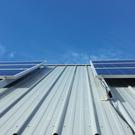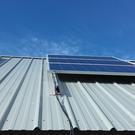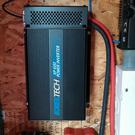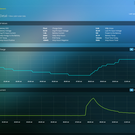Solar System Upgrades
Saturday, Jan 24, 2015
I recently experienced some issues with the cabin solar system due to a few weeks of mostly cloudy days combined with low temps. Due to the holidays I was unable to visit the cabin for a three week period and the batteries reached the system's low voltage disconnect state on Tuesday of the third week. I was also having a problem with the compressor on the refrigerator not able to start when it is cold. While these circumstances are atypical, I took the opportunity to perform a few upgrades to the cabin electrical system.
The biggest change was to transition the system from 12V to 24V which will cut the current draw of loads in half and greatly reduce voltage drop in wiring. Ideally this will allow the compressor in the refrigerator to start more easily (it will run on 12 or 24V).
Rewiring the batteries to 24V was simple. Instead of four 6V batteries in a serial/parallel arrangement, I now have four 6V batteries all wired in series for 24V. An added benefit is that only having one battery bank eliminates any potential for uneven charging.
So I went from a 12V 440AH bank to a 24V 220AH bank, which is obviously an identical amount of stored energy but more efficient overall.
Most of the current system components run fine on 12 or 24V, such as the cabin control system, power supply for the security cameras, etc. The two items that were specific to 12V were the inverter and water pump.
I've replaced the inverter with a new Exeltech XP600 24-volt 600 watt sine wave inverter which seems to be working great so far. I haven't yet replaced the water pump.
I also added an IOTA battery charger to the system so I can charge the batteries with the genset if/when the solar panels are unable to charge the batteries.
For additional monitoring of the system I installed a "Whiz Bang Jr" which is an add on device for my charge controller which measures all current going in or out of the batteries. It uses the same current shunt and essentially performs the same function as my existing Trimetric monitor but by being integrated with the charge controller I'm able to remotely monitor the data via the modbus/network interface. I've updated the cabin controller software to report on this data.
Another slight improvement was to wire the router/3G modem to run directly from the batteries (via the 12V power supply) so that the cabin controller can function remotely with the inverter powered off. This will allow me to power the inverter on and off remotely. For this I used a "power over ethernet" dongle that uses two of the unused ethernet cable wires for power so that I didn't need to run any additional wires.
I also made a couple of bus bars from copper rods and added a couple of switches so I can disconnect the battery charger and control system when needed.
Finally, I installed the remaining two solar panels I had originally purchased for the cabin. This brings the total to six panels and 870W.








